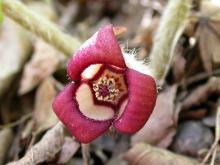Wildflowers, Grasses and Other Nonwoody Plants
Media

Species Types
Scientific Name
Potentilla simplex
Description
Common cinquefoil, or five-finger, is named for its leaves, which are divided into five fingerlike leaflets. One of seven cinquefoils in Missouri, it blooms from April to June and is scattered nearly statewide.
Media

Species Types
Scientific Name
Ranunculus fascicularis
Description
There are nearly 20 species in the genus Ranunculus in Missouri. Identify early buttercup by its early blooming time, its distinctively shaped, usually hairy leaves, and its preference for open woods, glades, or prairies.
Media

Species Types
Scientific Name
Ranunculus harveyi
Description
A slender little buttercup growing in rocky, dry areas with acidic soils, Harvey’s buttercup occurs mostly in southern Missouri. One key to identify it is to examine the basal and stem leaves, which are quite different.
Media

Species Types
Scientific Name
Polemonium reptans
Description
As pretty as this wildflower is, the common name “Jacob’s Ladder” comes from its ladderlike leaves, which made people think of the story from Genesis in which Jacob dreams of a ladder reaching up to heaven.
Media

Species Types
Scientific Name
Pueraria montana
Description
Of the many invasive nonnative plants that were originally introduced to stop soil erosion and improve soils, kudzu is one of the worst. This “vine that ate the South” is often the first plant that comes to mind when we think of “invasive plants.”
Media

Species Types
Scientific Name
Trillium sessile
Description
The flower of wake robin, or trillium, has 3 petals and 3 sepals, and 3 leaves that subtend the solitary flower. The petal color varies in this common woodland spring wildflower, but it is most commonly brownish or maroon.
Media

Species Types
Scientific Name
Trillium flexipes
Description
The largest trillium in Missouri has white petals, and when it blooms in spring, the flowers droop or hang sideways. Look for white wake robin in eastern and east-central Missouri, and in counties bordering the Missouri River.
Media

Species Types
Scientific Name
Asarum canadense
Description
In spring, wildflower lovers locate wild ginger by looking for its unique, hairy, heart-shaped leaves, then by stooping to view the small, three-parted brown flowers that form between the leaf bases, close to the ground.
Media

Species Types
Scientific Name
Lotus corniculatus
Description
Bird’s-foot trefoil forms low patches of bright yellow flowers along roadsides, having been planted to stabilize soil after road construction. Up close, it clearly has pea flowers. The leaves are cloverlike, with two leafy stipules at the base of each.
Media

Species Types
Scientific Name
Stylosanthes biflora
Description
Pencil flower is small and often overlooked. It has wiry stems, long, bristly hairs, three-parted leaves, and orangish-yellow flowers.
See Also
About Wildflowers, Grasses and Other Nonwoody Plants in Missouri
A very simple way of thinking about the green world is to divide the vascular plants into two groups: woody and nonwoody (or herbaceous). But this is an artificial division; many plant families include some species that are woody and some that are not. The diversity of nonwoody vascular plants is staggering! Think of all the ferns, grasses, sedges, lilies, peas, sunflowers, nightshades, milkweeds, mustards, mints, and mallows — weeds and wildflowers — and many more!





















